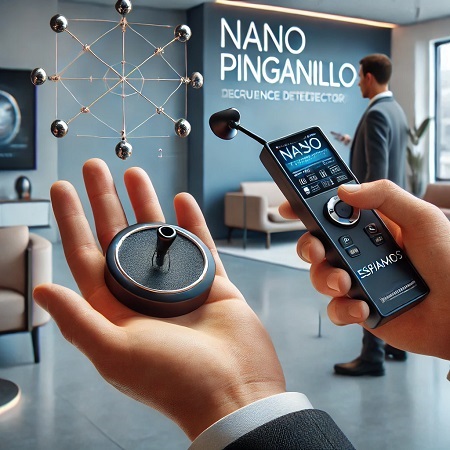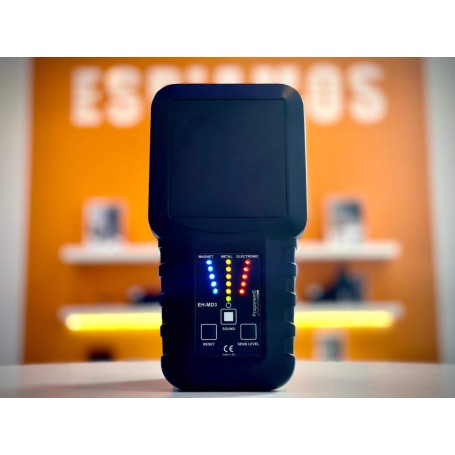Detecting a nano earpiece effectively is a crucial task in environments where academic integrity or security play an important role. These devices, also known as earpieces or micro earpieces , are nothing more than small neodymium magnets that receive electromagnetic waves from an inductive collar. Their simplicity and tiny size make them incredibly difficult to detect with the naked eye. However, with the right technology, such as electromagnetic field detectors, metal detectors, and frequency detectors, it is possible to locate them effectively.

Table of contents
- What is a nano earpiece and how does it work?
- Effective methods to detect a nano earpiece
- The use of electromagnetic field detectors
- Digital frequency detectors and their effectiveness
- Conclusions on the detection of nano earpieces
- Frequently Asked Questions (FAQ)
What is a nano earpiece and how does it work?
The nano earpiece is essentially a tiny neodymium magnet that receives audio signals using electromagnetic waves generated by a choke collar . Unlike other communication devices, this type of earpiece has no electronic components such as batteries or chips, making it much harder to detect. The choke collar is worn around the neck, usually hidden under clothing, and emits an electromagnetic field that interacts with the nano earpiece, transmitting sound without the need for wires or visible components.
The nano earpiece is virtually undetectable inside the ear canal, as its small size makes it invisible to the naked eye. It works in conjunction with an external device, usually a mobile phone, which connects to the earpiece using Bluetooth or GSM technology. This system allows an external person to send information to the person wearing it, making it a popular tool for cheating on exams or other high-risk activities.
It is important to note that since the nano earpiece has no battery or active electronics, its detection requires a different approach than traditional earpieces. However, with the right tools, such as electromagnetic field detectors and frequency detectors, the electromagnetic field generated between the inductive collar and the nano earpiece can be easily located.
Effective methods to detect a nano earpiece
Detecting a nano earpiece can be challenging due to its small size and lack of visible electronic components. However, there are several effective methods that allow these devices to be located accurately. Below, we will explore the most commonly used methods for detecting nano earpieces in environments such as exams or auditoriums.
Visual inspection and suspicious behavior
Although nano earpieces are extremely small, users may exhibit suspicious behavior that could give away their use. Frequent movements toward the ear, head, or continuous adjustments to the neck (where the neck collar is located) can be signs that someone is using such a device. However, this method is not foolproof, as nano earpieces are specifically designed to be invisible and worn discreetly.
Using metal detectors
Metal detectors are an effective tool for detecting nano earpieces , as they are made with neodymium magnets. Since the nano earpiece is completely metallic, a suitable metal detector can identify its presence in the user's ear. At ESPIAMOS , we offer a specialized metal detector that is capable of locating these small devices accurately. This method is a fast and efficient option for identifying the use of a nano earpiece in risky situations.
Electromagnetic field detectors
The electromagnetic field detector is another key tool in the detection of nano earpieces. This device is capable of capturing the electromagnetic field generated between the inductive collar and the nano earpiece. By identifying these fields, examiners can detect the presence of an inductive collar and, therefore, the use of a nano earpiece. At ESPIAMOS, we have the 3HECA Mini , a nano earpiece detector that combines the detection of electromagnetic fields, metals and electronic devices, providing a comprehensive solution for the detection of these hidden devices.
Using electromagnetic field detectors to locate nano earpieces
One of the most effective methods for detecting a nano earpiece is through the use of electromagnetic field detectors . These devices are designed to identify variations in the electromagnetic fields that are generated between the inductive collar and the nano earpiece. Since the inductive collar emits an electromagnetic field to transmit sound to the nano earpiece, this field can be easily detected with the appropriate equipment.
The 3HECA Mini , available at ESPIAMOS, is an example of a highly efficient electromagnetic field detector. This device not only detects fields generated by electronic devices such as the inductive collar, but also the presence of metallic objects, making it a versatile tool for the detection of technological cheating in academic and security environments. In addition, it works simultaneously on multiple channels, allowing multiple signals to be detected at the same time, maximizing accuracy and speed in the identification of nano earpieces.
How does the 3HECA Mini detector work?
The 3HECA Mini combines three key technologies for the detection of hidden devices: metal detection, electromagnetic fields and active electronic devices. Thanks to its compact and discreet design, this detector can be used in any type of inspection without raising suspicion. Its main advantage is that it works simultaneously on all detection channels, providing real-time results on any hidden object found in the search area.
Electromagnetic field detection is particularly important when it comes to identifying a nano earpiece , as this device does not generate active frequencies of its own, but relies entirely on the electromagnetic field generated by the inductive collar. The 3HECA Mini is able to detect this field, alerting to the presence of the audio transmission system that connects the nano earpiece to the outside.
In addition to its ability to detect electromagnetic fields, the 3HECA Mini also features a metal detector , which can identify metallic objects such as the nano earpieces in the user's ear. This detector emits a visual or audible alarm signal when it finds hidden metal, making it easier to locate the device.
Digital frequency detectors and their effectiveness
Another key method for detecting nano earpieces is the use of digital frequency detectors . These devices are responsible for picking up wireless signals, such as Bluetooth, GSM or WiFi, which are used to connect the earpiece to a mobile phone or other communication device. Although the nano earpiece itself does not emit signals, the earpiece and the mobile phone do, and this is where frequency detectors come into play.
An example of an effective digital frequency detector is the iProtect 1216 , an advanced tool that monitors a wide range of frequencies and is able to locate signals coming from nearby transmitting devices. The nano earpieces They usually work in combination with Bluetooth earpieces, so by detecting the Bluetooth signal generated by the collar, the examiner can immediately identify that an earpiece is being used.
Why is frequency detector important in exams?
The use of frequency detectors in exams is crucial to ensure fairness in assessments. By being able to identify the signal emitted by the choker or mobile device attached to the nano earpiece, frequency detectors allow examiners to quickly locate the source of cheating. This is especially useful in situations where students attempt to cheat using advanced technologies that are almost impossible to detect with the naked eye.
Moreover, frequency detectors are not only useful in academic exams, but also in auditoriums and conference rooms where security needs to be ensured and information leakage prevented. By constantly monitoring active frequencies, these detectors alert to the presence of any device that is transmitting information wirelessly.
Transparency in detection and collaboration with SAFE EXAM®
At ESPIAMOS® we collaborate with initiatives such as EXAMEN SEGURO® to ensure that educational institutions have the necessary tools to maintain the integrity of their assessments. Through the combination of frequency detectors , electromagnetic field detectors and metal detectors , we provide effective solutions to eradicate the use of nano earpieces and other cheating devices in exams.
Transparency in the use of these detectors is essential to discourage students from trying to cheat. Informing about the possibility of being monitored with these tools creates an environment of trust and respect for the rules, ensuring that all participants in the exam have the same opportunities.
Conclusions on the detection of nano earpieces
Detecting a nano-earphone in an exam may seem like a challenge, but with the right tools, such as digital frequency detectors , electromagnetic field detectors , and metal detectors , it is possible to do so quickly and effectively. These devices are essential to maintaining academic integrity and ensuring that exams are conducted on a level playing field.
The nano earpiece, although extremely small and discreet, relies on a series of electronic elements that can be easily detected if the right tools are used. The 3HECA Mini , with its ability to identify electromagnetic fields and metal objects, is one of the most versatile devices in this type of situation. On the other hand, frequency detectors such as the iProtect 1216 can identify the signals emitted by the inductive collar or the accompanying mobile phone, ensuring complete detection of the trap system.
At ESPIAMOS®, we are committed to offering the best technological solutions for the detection of cheating devices in exams. Our collaboration with EXAMEN SEGURO® and the use of advanced technology positions us as leaders in the fight against academic fraud, ensuring that each exam is conducted in a fair and equitable manner.
Detecting is easier than copying
Although students may think that using a nano earpiece guarantees that they will remain undetected, the truth is that detection technology has advanced to the point where detecting these devices is much easier than it seems. Tools such as frequency detectors and electromagnetic field detectors are capable of identifying any attempt to cheat, so efforts to cheat on an exam with advanced technology are easily thwarted with the right devices.
Frequently Asked Questions (FAQ) about nano earpiece detection
What is a nano earpiece?
He The nano earpiece is an extremely small magnet, which is placed inside the ear canal and allows the user to receive information through an inductive collar. This device has no battery and does not emit any signals of its own, which makes it difficult to detect visually, but it can be located using metal detectors and electromagnetic fields.
How can you detect a nano earpiece?
The nano earpiece can be detected using a combination of frequency detectors , electromagnetic field detectors and metal detectors . Frequency detectors pick up signals from the inductive collar or mobile phone, while electromagnetic field detectors identify the field generated between the collar and the nano earpiece. Metal detectors, meanwhile, can locate the earpiece's neodymium magnet.
Is the nano earpiece completely undetectable?
Although the nano earpiece is very small and designed to go unnoticed, it is not completely undetectable. With the right technological tools, such as frequency detectors and electromagnetic field detectors , it is possible to locate the accompanying system and dismantle any attempts at cheating.
Which institutions can benefit from these detectors?
Any educational institution that wishes to ensure the integrity of its examinations can benefit from the use of frequency detectors and electromagnetic field detectors . These devices are also useful in other situations where security is a priority, such as auditoriums, conferences or meetings where information leakage must be prevented.
Is it legal to use frequency detectors in exams?
In most countries, the use of frequency detectors and other screening tools in exams is completely legal, as long as it is done within the regulatory framework of the institution. It is recommended that institutions inform students about their use to avoid any privacy or legality issues.






 WhatsApp
WhatsApp Telegram
Telegram



